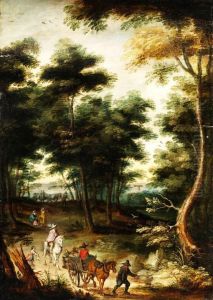Jan Brueghel Le Vieux Paintings
Jan Brueghel the Elder, also known as Jan Brueghel the Elder or Jan Brueghel de Velours due to the silky texture of his works, was a prominent Flemish painter and draughtsman born in 1568. He hailed from an illustrious family of artists; his father was Pieter Bruegel the Elder, a pioneer in the development of landscape and genre painting in the 16th century, and his brother Pieter Brueghel the Younger also became a successful artist. Despite the early death of his father, Jan Brueghel's artistic lineage provided him with a foundation that greatly influenced his career.
Brueghel's upbringing was marked by the turmoil of the Spanish occupation of the Netherlands. After his father's death, his mother moved the family to Antwerp, where he was apprenticed to the landscape painter Pieter Goetkind. Brueghel traveled extensively, including to Italy in the 1590s, where he worked for Cardinal Federico Borromeo in Milan and was influenced by the works of Italian masters. This period was crucial for the development of his distinctive style, which combined meticulous detail with rich, atmospheric landscapes.
Returning to Antwerp, Jan became a master in the city's Guild of Saint Luke by 1597. He collaborated with prominent artists of the time, such as Peter Paul Rubens, with whom he created works that combined Rubens' figures with Brueghel's landscapes. Brueghel was renowned for his ability to depict nature with accuracy and was often referred to as 'Flower Brueghel' for his lush floral pieces. His works included allegorical paintings, garland paintings, landscapes, seascapes, and detailed still lifes.
Jan Brueghel the Elder's paintings were sought after by collectors and patrons, including royalty. His artistic output was prolific, and his works were instrumental in the development of new genres in Flemish art. He also played a significant role in the transition from Mannerist to Baroque styles. Brueghel died in Antwerp on January 13, 1625, leaving behind a legacy that would influence generations of artists. His sons, Jan Brueghel the Younger and Ambrosius Brueghel, continued the family tradition, becoming successful painters in their own right.






